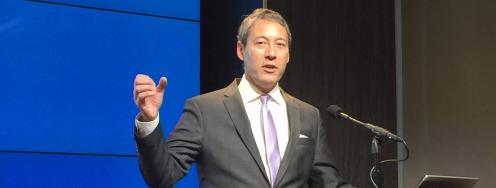Seeing Eye to Eye with China
I just returned from a week in Beijing. What a change. Scores of modern skyscrapers with international brand names and products emblazoned atop have sprung up where none existed as little as five years ago. Shining shopping malls are filled with the latest fashions and products. Streets are choked with thousands of cars and buses where packs of bicycles and motorcycles once ruled.
The physical manifestations of economic growth were truly stunning, but after more than 10 years since my last visit to China, I was more intrigued by what I found beneath the surface – an unexpected sense of vulnerability about the world that the Chinese share with Americans. I was confronted again by a basic difference that Chinese and Americans have when trying to solve complex problems. This particular mix of similarity and divergence has the potential to either foster increased cooperation between the world’s two most important countries or to serve as a wedge for greater rivalry.
Everyone’s worried about China.
As the U.S. slowly makes its way out of recession, the reported “rise of China” has become a symbol for overall unease. Watching the flight of jobs, manufacturing and capital to China, some blame the booming Chinese economy for our domestic woes. Americans have a nagging sense that a better life for our children, once a given for generations of Americans, is no longer a sure thing. We have the largest economy in the world, the most powerful military the world has ever known, and thousands of nuclear weapons, and yet we don’t feel secure.
Ironically, the Chinese share this sense of vulnerability. Their worries focus not on the U.S., however, but on themselves. The Chinese are understandably proud of China’s status as the world’s second largest economy and a leader in the international community. Nevertheless, that pride is unexpectedly accompanied by a genuine sense of fragility -- the common refrain that China is still a “developing” country, implying it should somehow be held to a slightly different standard. Many are convinced the U.S. actively seeks to curtail China’s development. Within this context, the Chinese plainly worry about the country’s ability to address the longstanding challenges: disparity between the wealthy coastal regions and the deprived interior; the lack of jobs for the urban poor who are flooding into city centers looking for work; and profound environmental contamination that will significantly hamper future growth.
Our two nations are increasingly intertwined. Together they account for roughly one third of the world’s GDP. Every year, trade between the two nations reaches approximately $500 billion and swap something close to 172,000 students. Given these ties, our prominence and shared sense of vulnerability -- as well as the need to minimize risk to “black swans” (like 9/11 or the Crash of 2008) -- would seem to create a basis for a close U.S.-China relationship.
However, there remains an impediment to closer U.S.-China relations, apart from what one would expect in the face of some incongruities in national interests. In my conversations with Chinese colleagues, I was quickly reminded how differently Chinese and Americans approach problems. Of course there are exceptions, but as a general rule Americans tackle thorny issues from the “bottom-up” while Chinese do so from the “top-down.”
Talking past each other.
Americans have a tendency start with specifics, get to the gist of what they see as a problem, and then move quickly to a solution. From practical discussions and frequent interactions, individuals supposedly will gain greater familiarity, develop trust and evolve a common understanding about the “big picture.” The Chinese, on the other hand, tend to start with the big picture, have a desire for agreement on the circumstances surrounding a matter, and then move to details after a sense of trust has been established. Americans think every problem can be solved if enough hard work and creativity is applied, a reflection of the American “can do” spirit. In contrast, Chinese believe some problems cannot be solved in the short-term. Therefore, they often seek to focus on efforts to shape the long-term environment.
A great example of this differing mindset is the U.S. and Chinese approach to North Korea. U.S. government policy concentrates on the North’s nuclear weapons – the specific that most concerns Americans - and devotes significant resources to containing and rolling back its program. Chinese policy, on the other hand, is designed to spur the new leadership of Kim Jong Un to PRC-style economic reforms. The Chinese argue that with a more open economy North Korea will eventually decide that nuclear weapons are not all that useful.
But North Korea is also an example of a larger issue -- how dissimilar mindsets can lead to weariness or disappointment. Theoretically, the American and Chinese approaches to North Korea policies are not necessarily incompatible with proper coordination. However, this kind of active management hasn’t happened. As a result, there is mutual frustration as the situation in North Korea worsens. To be sure, North Korea is just one of many areas of friction between the two countries. Particularly problematic are the broader, more fundamental security issues between the two, including missile defense and nuclear weapons policy. Even more points of contention arise around China’s significant naval and missile build up, the Pentagon’s “rebalance” toward Asia, and growing territorial disputes in the Pacific as the two Security Council members compete for regional influence. As China and the U.S. talk past each other on these sensitive topics, inaccurate assumptions can harden; lingering doubts turn into deeper suspicion and hostility.
The challenge facing the U.S. and China is as old as the ages – what is the nature of the relationship between an emerging power and an established power? Does it become a collaborative partnership, a healthy competition, or an intense rivalry?
Each country’s sense of vulnerability, combined with the opposite ways we take to dealing with problems (and adding a dash of real mistrust), means a lot of hard work will be necessary to forge an effective partnership. But as the U.S. and China complete their respective leadership choices, a critical start will be for both sides to recognize the exposure that each feels toward the other, and an understanding that each has a distinct way of going about its business – one that demands extra patience and time to move forward.
Ploughshares Fund executive director Philip Yun recently returned from a week in Beijing.




